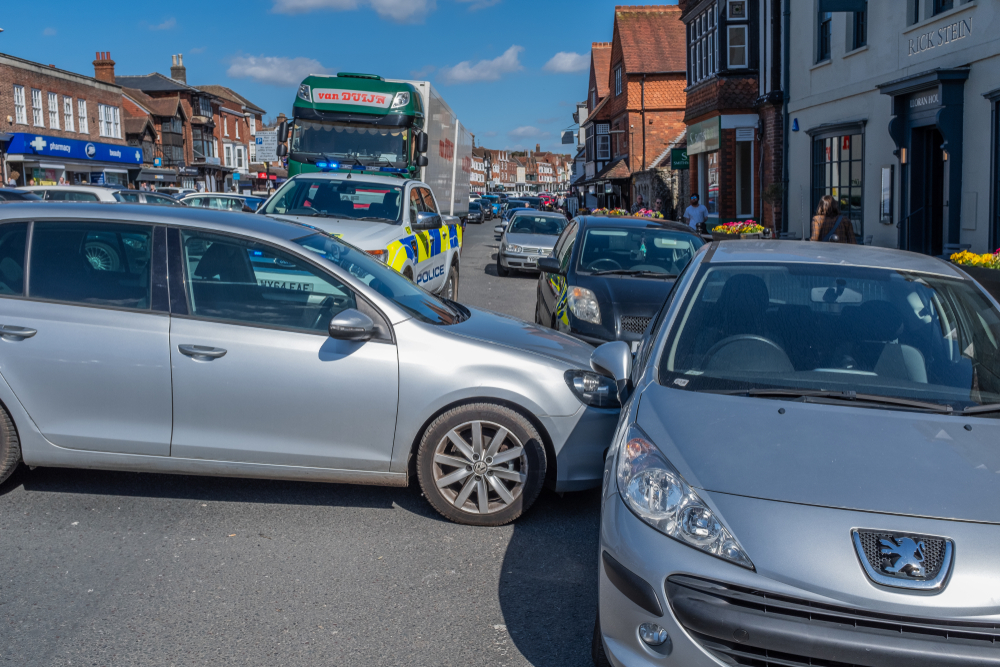In a T-bone accident, the driver who violated the right-of-way is typically found to be at fault. These frightening side-impact collisions often happen at intersections when one driver fails to obey a traffic signal or stop sign, crashing into the side of another vehicle. However, determining legal responsibility isn't always straightforward, as multiple factors can contribute to a crash. A car accident lawyer can help clarify how Texas law assigns liability in these complex cases.
p style="text-align: center;">Schedule a Free ConsultationKey Takeaways for Who Is at Fault in a T-Bone Accident
- Fault in a T-bone accident generally rests with the driver who failed to yield the right-of-way, such as by running a red light or a stop sign.
- Texas operates under a modified comparative fault rule, meaning a person's compensation can be reduced by their percentage of fault, and they can be barred from recovery if they are 51% or more at fault.
- Determining who is at fault involves a detailed investigation of evidence, including police reports, witness statements, traffic camera footage, and analysis of vehicle damage.
- More than one party can be held responsible for a collision, including other drivers, government entities for unsafe road conditions, or vehicle manufacturers for defective parts.
Understanding T-Bone Accidents and Right-of-Way in Texas
A "T-bone" accident, also known as a side-impact or broadside collision, occurs when the front of one vehicle collides with the side of another, forming a "T" shape. These crashes are particularly dangerous because the side of a vehicle offers far less protection to occupants than the front or rear, which have crumple zones designed to absorb impact.
The core issue in most T-bone accident cases is the "right-of-way." This is not just a courtesy; it's a set of traffic laws that dictate who has the legal right to proceed in a given situation. When a driver violates these rules, they are often acting negligently. Negligence is a legal term for failing to use the same level of care that a reasonably careful person would in a similar situation, resulting in harm to someone else.
In Texas, the rules for right-of-way are outlined in the Texas Transportation Code. Common intersection scenarios where right-of-way is critical include:
- Traffic Lights: Drivers must obey red, yellow, and green signals. A driver who enters an intersection on a red light and causes a T-bone crash has clearly violated the right-of-way of drivers with the green light.
- Stop Signs: At an all-way stop, the driver who arrives first has the right-of-way. If two drivers arrive simultaneously, the driver on the right proceeds first. At a two-way stop, drivers must yield to all cross-traffic before proceeding.
- Unprotected Left Turns: A driver making a left turn at an intersection without a green arrow must yield to all oncoming traffic. Misjudging the speed or distance of an approaching vehicle is a frequent cause of devastating T-bone accidents.
Understanding these fundamental traffic laws is the first step in analyzing who was responsible for the collision.
Common Causes of Devastating T-Bone Accidents
While a right-of-way violation is the direct cause of a T-bone crash, that violation is often the result of another negligent behavior. A thorough investigation looks beyond the immediate action to uncover the root cause, which is essential for holding the correct party accountable.
Some of the most common underlying causes include:
- Distracted Driving: This is a leading cause of all types of accidents. A driver who is texting, talking on the phone, adjusting the radio, or otherwise not paying full attention to the road can easily miss a red light or stop sign.
- Driving Under the Influence (DUI/DWI): Alcohol and drugs impair a driver's judgment, reaction time, and coordination. An intoxicated driver is far more likely to make a poor decision at an intersection, such as speeding through a yellow light or failing to see oncoming traffic.
- Aggressive and Reckless Driving: Speeding, weaving through traffic, and intentionally running red lights are all forms of aggressive driving that dramatically increase the risk of a T-bone collision.
- Driver Inexperience: Newer drivers may not have the experience to properly judge gaps in traffic when making a left turn or may panic in a complex intersection.
- Poor Weather Conditions: Rain, fog, or glaring sun can reduce visibility, making it harder for drivers to see traffic signals or other vehicles. While weather can be a factor, drivers have a responsibility to slow down and adjust their driving for the conditions.
These factors demonstrate that the cause of a T-bone accident is often a clear and preventable choice made by a negligent driver.
How Is Fault Determined in a Texas T-Bone Accident?

Simply stating that the other driver ran a red light is not enough to prove fault in a legal claim. Understanding what to do after a car accident is essential because insurance companies will demand concrete evidence before agreeing to pay compensation for medical bills, lost wages, and other damages. Building a strong case requires gathering and preserving as much evidence as possible.
The investigation into your T-bone accident will rely on several key pieces of information:
- The Police Accident Report: An officer from the Abilene Police Department or another local agency will respond to the scene and create an official report. This report contains the officer’s initial observations, diagrams of the crash, statements from drivers and witnesses, and sometimes a preliminary assessment of fault.
- Photos and Videos: Visual evidence is incredibly powerful. Photos of the vehicle damage, skid marks on the road, the final resting positions of the cars, and the intersection itself can help reconstruct how the accident happened.
- Witness Statements: Independent witnesses who saw the collision can provide an unbiased account of what happened. Their testimony about which driver had the green light or who failed to stop can be crucial.
- Traffic and Surveillance Footage: Many intersections, especially along busy roads in Abilene and San Angelo, have traffic cameras. Nearby businesses may also have security cameras that captured the crash. This video evidence can often definitively prove what occurred.
- Accident Reconstruction Analysis: In complex cases, a professional may be brought in to analyze the physical evidence. By examining vehicle damage, roadway marks, and other data, they can scientifically determine factors like vehicle speeds and points of impact to establish a clear sequence of events.
Each piece of this puzzle helps create a comprehensive picture of the moments leading up to the T-bone accident, establishing a clear basis for a fault determination.
If at this point you’re wondering how much a personal injury lawyer costs, the good news is that most attorneys work on a contingency fee basis. This means you don’t pay anything upfront for legal representation. Instead, your car accident lawyer only gets paid if they successfully recover compensation on your behalf.
What is Modified Comparative Fault in Texas?
Texas uses a legal doctrine called "proportionate responsibility," more commonly known as modified comparative fault. This rule is incredibly important for anyone involved in a car accident. Here’s how it works in simple terms:
- A percentage of fault is assigned to everyone involved in the accident.
- If you are found to be partially at fault, your total compensation award is reduced by your percentage of fault. For example, if you are found to be 20% at fault, your final recovery would be reduced by 20%.
- The "51% Bar" Rule: This is the most critical part. In Texas, you cannot recover any compensation at all if you are found to be 51% or more at fault for the accident.
Because of this rule, the at-fault driver's insurance company will often try to shift as much blame as possible onto you, even if their driver was clearly negligent. They know that if they can convince a jury that you are 51% or more responsible, they won't have to pay anything. This is why having strong, undeniable evidence of the other driver's fault is so vital to protecting your rights after a T-bone accident.
Potential Parties Who Could Be at Fault for a T-Bone Accident
While the other driver is the most likely at-fault party, they aren't the only possibility. A detailed investigation may reveal that another person or entity shares responsibility for the crash.
- The Other Driver: This is the most common scenario, where a driver's negligence—such as speeding, distraction, or intoxication—directly causes the T-bone collision.
- A Third-Party Driver: Sometimes, the actions of a "phantom" driver contribute to a crash. For example, if a third car illegally cuts off another vehicle, forcing it to swerve and run a red light, that third driver could share in the liability.
- A Government Entity: A city or county has a duty to maintain safe roads. If a T-bone accident was caused by a malfunctioning traffic light, a stop sign obscured by overgrown trees, or a dangerously designed intersection, the government entity responsible for its maintenance could be held liable.
- A Vehicle Manufacturer: If the crash was caused by a sudden mechanical failure, such as brake failure or a steering system defect, the manufacturer of the vehicle or the specific faulty part could be responsible under product liability laws.
Identifying all potential sources of liability is a key part of the legal process to ensure you can pursue the full compensation you deserve, and understanding when to get an attorney for a car accident can make a major difference in protecting your rights from the start of your case.
FAQs: Who Is at Fault for a T-Bone Accident?
Here are answers to some common questions that arise after a serious side-impact collision.
This is a very common dispute in T-bone accidents. In these "he-said, she-said" situations, fault is determined by looking at external evidence. This can include testimony from independent witnesses, data from traffic light sensors, or footage from nearby surveillance cameras. An accident reconstructionist may also analyze the vehicle damage and debris field to determine which vehicle had the right-of-way.
It is extremely rare for a passenger to be held at fault. A passenger could only be considered liable if they did something to actively cause the crash, such as grabbing the steering wheel or intentionally distracting the driver at a critical moment. In nearly all cases, passengers are considered blameless victims who have a right to seek compensation from any at-fault drivers.
In Texas, the statute of limitations for most personal injury claims, including those from car accidents, is two years from the date of the incident. This is a strict deadline, and if you fail to file a lawsuit within that two-year window, you will likely lose your right to recover any compensation.
Yes, the point of impact can provide important clues about how the accident happened. For example, an impact near the front of your car might suggest you had almost cleared the intersection, while an impact on the rear passenger door could indicate the other driver ran a red light long after it changed. This physical evidence is often used to help prove fault.
If the at-fault driver was on the job at the time of the T-bone accident, their employer may also be held liable under a legal principle called "respondeat superior." This can be beneficial for the injured person, as companies typically carry larger insurance policies than individual drivers.
Contact a Dedicated Abilene & San Angelo Attorney Today

A T-bone accident can leave you with serious injuries, mounting medical bills, and a great deal of uncertainty. You shouldn't have to manage the complex legal and insurance process alone while trying to recover. Determining fault and holding the responsible party accountable requires a careful investigation and a thorough understanding of Texas law.
At the Law Offices of David M. White, we are committed to helping people in Abilene and San Angelo get through these difficult times. Our personal injury lawyers understand the stress you are under, and our team is ready to carry the legal burden for you, fighting to protect your rights and pursue the financial recovery you need to move forward.
If you or a loved one has been injured in a T-bone collision, contact our firm today at (325) 437-3311 or through our online form for a free, no-obligation consultation to discuss your case.
p style="text-align: center;">Schedule a Free Consultation